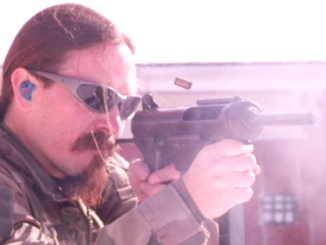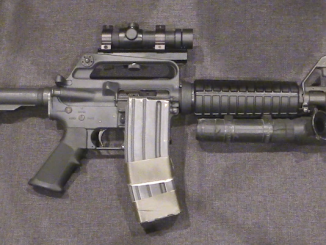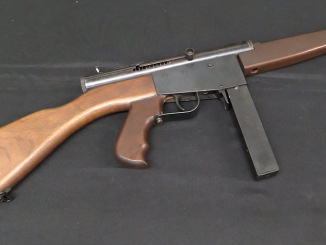For the full episode with the hand loading instructional section, click here:
https://forgottenweapons.vhx.tv/videos/trapdoor-app-cut
Black powder military rifles of the 1860s-1880s are a really enjoyable group of guns. A lot of them are relatively reasonably priced, and they are actually pretty easy to reload for. The unavailability of factory ammunition (for most, although not so much for the Trapdoor) makes them seem like a daunting prospect, but for a pretty simple investment in tools and time one can make up ammunition and have a lot of fun with rifles like this.
That’s the idea behind a new series here on black powder military rifles. Each moth, my friend – and handloader – Tom and I will take out a different model to have some fun at the range and compare how they handle. And then we will show you how to make the ammunition for them. So grab your pith helmet, pause “Zulu” and join us! Today is Episode One: Trapdoor Springfield!




The speed-shooting trick with trapdoors is to hold cartridges between your support hand fingers so you don’t have to grab into your cartridge pouch. This might not (probably won’t) work for a leftie, but I was able to strip the cartridges one-by-one without breaking my support hand grip.
I was aware of this truck, but had to try it left-handed out of idle curiosity. It’s a little awkward, but it absolutely works. Good tip!
The more you see of the single-shot rifles of a century and two-thirds ago, the more you can appreciate the genius of first Walter Hunt (who invented the tubular-magazine lever-action repeating rifle with self-contained ammunition), Benjamin Tyler Henry (who made it work), Oliver Winchester (who made it commercially viable), and of course John Moses Browning (who perfected it).
The greater range and power of the .45-70 was sort of irrelevant when the opposition had a Winchester in .44 WCF. Within 200 meters,he could shoot a trapdoor-armed soldier two or three times in the space of time it took said soldier to load and fire once.
Whether you believe the Plevna 1877 story or not (I have doubts), the fact that it’s mostly been believed for 147 years says a great deal about the fundamental superiority of the lever-action repeating rifle in its era.
For that matter, the lever gun is still a pretty serious all-around “utility” rifle, even today. It’s about as fast and accurate as the typical self-loader for the first six to ten rounds, and often, that’s enough. Not least because lever-actions still chamber cartridges which hit harder than either 5.56 x 45mm or 7.62 x 39mm out to 200 meters, and that’s about as far as any rifleman with an ounce of sense is going to take a target under fire to begin with.
clear ether
eon
“(…)genius of first Walter Hunt (who invented the tubular-magazine lever-action repeating rifle with self-contained ammunition), Benjamin Tyler Henry (who made it work), Oliver Winchester (who made it commercially viable), and of course John Moses Browning (who perfected it).(…)”
Wait, for me Christopher Spencer is missing there, why?
Spencer’s design was sadly a dead-end development. The magazine in the stock could not be readily adapted to having a loading port, so reloading (even with a Blakeslee box full of tubes) was always a clumsier process.
Also, the Henry design was recocked automatically when the action was cycled; the Spencer had to have its big hammer thumb-cocked manually like a rifle-musket.
The Spencer was certainly sturdier than the original Henry, but the Dodge and King modifications resulting in the Winchester solved that problem.
Spencer really should also be remembered for his two later accomplishments. First, his pump-action shotgun that set the pattern for every non-automatic repeating shotgun since, right down to the present day.
Second, in 1901 he partnered with Herman Hollerith, late of the U.S. Census Bureau, to make tabulating machines for business. Hollerith was the first to use punch cards (a French invention) with electrically-operated tabulators for Census calculations.
In 1912, they changed the company’s name to Business Machines Inc., as by then they were making tabulators, adding machines, and typewriters. They made their first electric typewriter in 1919.
In-between times Spencer became a licensed pilot. His teacher was Orville Wright.
In 1921, not long before his death, Spencer added the word “International” to the name of the company. It still bears that name today. International Business Machines, Inc.
Yes. Christopher Spencer was the founder of IBM.
cheers
eon
I didn’t know about the IBM connection for Spencer. I’d always wondered why there wasn’t all that much follow-up to his earlier rifle designs, and now I know…
Funny how that’s never mentioned in any of the IBM encomiums you run into.
The trapdoor design was not great in combat with the adrenaline flowing and soldiers hiding behind whatever they could find and shooting in awkward postures. The door kept flapping shut. Plus there were many instances where, as the barrel heated up or the casing ruptured, the spent cartridge would not eject. Not real useful in the heat of combat.
That problem was more to do with early case design , brass head paper body , brass head, coiled copper body , one other can’t thing of right now . When the got good brass cases of the modern type the ejection problem went away .
Iron head with paper body. “Composite” cases were a problem for the British Army as late as Majuba Hill (1881), by which time the U.S. Army had been using drawn brass cases for fifteen years (1867).
The British got stuck with first iron and paper and then brass head and copper foil cases simply because they were cheap. The Parliament just didn’t want to invest in brass-drawing machinery at Enfield Lock.
The U.S. Army never used “composite” cases, going to one-piece metallic cartridges as soon as they adopted breechloaders. The Army had enough trouble with copper one-piece cases in the converted Colt and Remington .44 and .38 centerfire revolvers (notably those made by the U.S. Cartridge Co.), that by 1872 they were using drawn-brass cases exclusively, mostly made at Frankford Arsenal, which also made .50-70 and .45-70 rifle ammunition.
clear ether
eon
Once again, “mil-spec” doesn’t mean best, it just means best in our price range. These were still so vastly superior to a rifle musket that there’s no comparison. If only they’d had better cartridge cases.
There were better options for converting the muskets and just plain better breech loading rifles. In 1873 when the conversion of existing muskets was stopped, then the whole issue of reevaluating which rifle to use should have been done. But stories I read indicated that Allin had mega stroke at the Springfield Arsenal and would not allow any other option than his baby.
He got Jacob Snider fired from Springfield, on grounds of “insubordination”. (Note that Snider was a civilian employee of the Armory, not a serving officer.)
As a result it was the British Army that got the simpler, sturdier and much more intelligently-designed Snider conversion for the Pattern 1853 Enfield 0.577in rifle.
Meanwhile the U.S. government was getting sued by Hiram Berdan’s widow for Allin ripping off the (patented) Berdan I breech system.
Erskine Allin was a grifter on roughly the same level as Rollin White. Both were patent trolls who should never have been employed by anybody.
clear ether
eon
“Insubordination” is a common reason for dismissal in civilian companies too. There is nothing suspicious about such a reason being cited in the case you reference. Though yes, said dismissal might or might not have been warranted
“(…)Allin had mega stroke at the Springfield Arsenal and would not allow any other option than his baby.”
In similar time Krnka system was selected as upgrade to existing muzzle-loading fire-arms. Baranov system https://www.militaryrifles.com/russia/baranov lost, but inventor managed to subvert Nikolay Putilov (see Kirov Zavod) into supporting his system. Using connections with future czar Alexander Peacemaker manage to secure order for 10000 examples and actually made 9872 examples made. Then-current czar stop that, finally deciding already procured converted rifles will be delivered to Navy.
Sylvester Krnka’s breech was basically an unlicensed copy of the Joslyn breech action. Like Allin, Krnka was more of a copycat than an inventor.
clear ether
eon
“Sylvester(…)Joslyn(…)copycat(…)”
Wait. Had former access to time machine? If no how you would explain that former made his breech-loader in 1854, see https://www.krnka.cz/dilo-mistra/rychlostrelka-sylvestra-krnky-z-roku-1855-6/ that is before Joslyn production started in 1855?
The original rifle load was 405 grain bullet with 70 grains of musket powder and the carbine load was the same bullet with 55 grains of musket powder. In the 1880’s the rifle load was changed to a 500 grain bullet with 70 grains of musket powder, for better long range performance. The Army when dealing with Indians realized that letting them get close was a bad idea, so standard practice was to go to cover, keep the Indians beyond 200 yards and use the superior long range accuracy and power of the 45-70 to keep them beyond 200 yards. The trapdoor carbine with its particular load was superior to what the Indians had beyond 200 yards. With rare exceptions (Little Big Horn) the Indians weren’t interested in a fight to the finish. The Army usually used the Cavalry to heard them towards infantry in blocking positions. Once the Indians realized they couldn’t get away, they surrendered to fight another day. The introduction of the 500 grain load coincided with the introduction of the Buffington rear sight. This style of fighting the Indians, by keeping them beyond 200 yards, explains why the Army, in the late 19th century, became enamored of long range target shooting.
I suspect that the half cock notch only had a workout under supervision at the range. Under pressure, cocking it all the way saves time. That’s certainly the way I shoot mine.
And they do get hot!